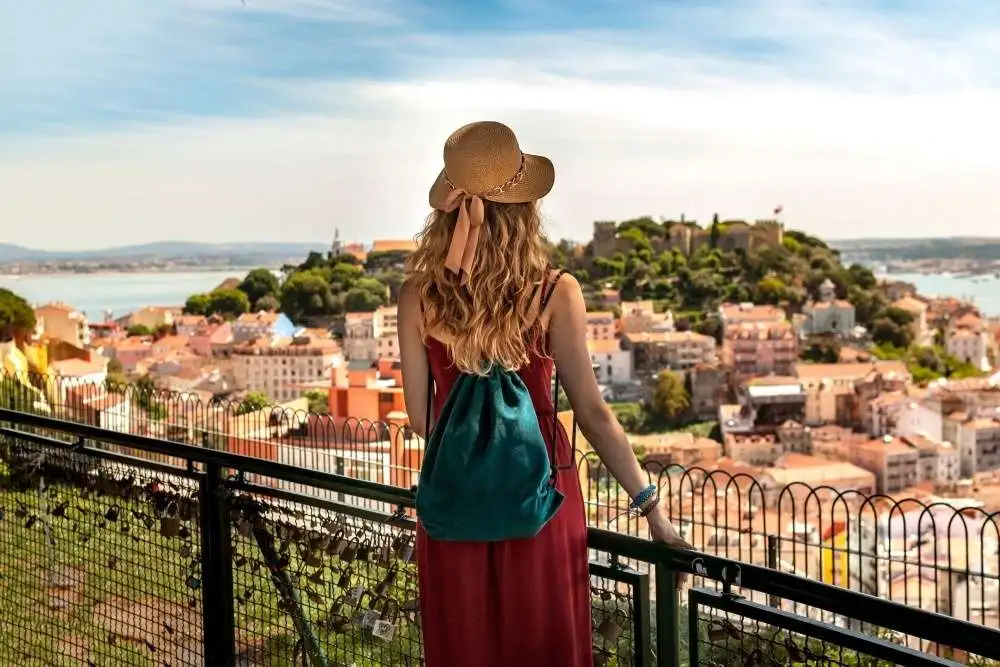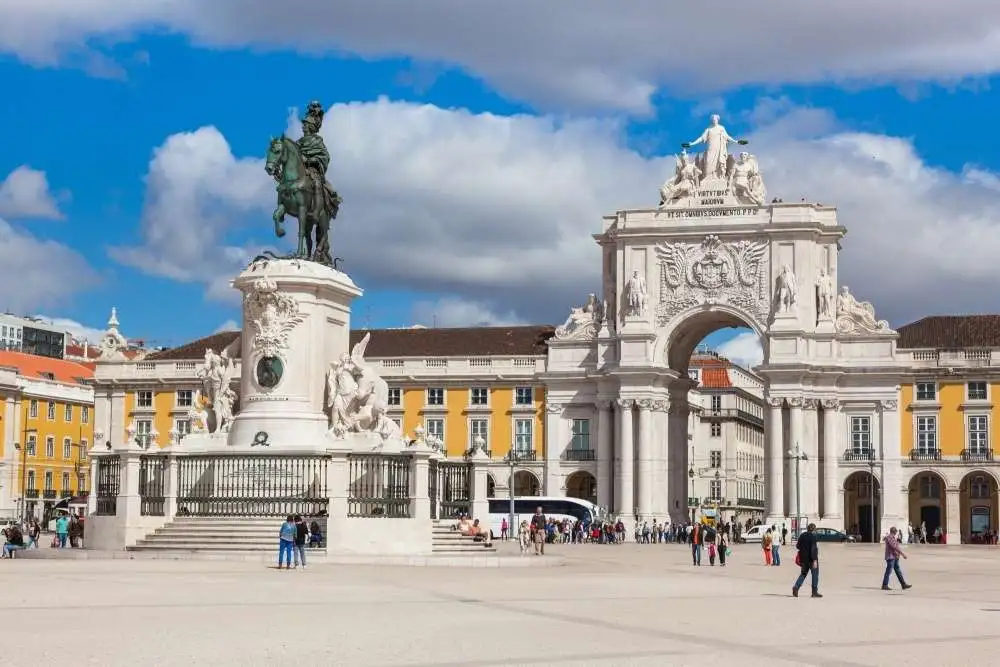- Home
- Lisbon Day Trips
- Lisbon Highlights
- Hotel Pickup
- Private Tour
Discover the most charismatic districts of Lisbon, on a private half-day Lisbon Tour.
Get to know Belem - the Age of Discoveries district -, and contemplate the Jeronimos Monastery, Tower of Belém and Monument to the Discoveries while you savor the one-of-a-kind "Pastéis de Belém" (portuguese custard tarts).
See the legendary Old Lisbon medieval streets and breathtaking viewpoints.
Book
Schedule
| Tuesday to Saturday | 8.30 AM - 12.30 PM |
Price
per person| 2 people | 98€ |
| 3 people | 80€ |
| 4 people | 75€ |
| 5 people | 60€ |
| 6-7 people | 50€ |
- English-Speaking Licensed Guide
- Transport at Air-Con Vehicle
- Bottled Water
- Wi-fi
- Entrance tickets (sightseeing tour)
- Food
Lisbon Tour Itinerary
Lisbon hotelMedieval Lisbon: Alfama (stop at viewpoint)
Belém: Jeronimos Monastery (outside), Tower of Belém (photo stop), Monument to the Discoveries (stop), "Pastéis de Belém" (portuguese custard tarts - stop)
City Center (sightseeing tour): Avenida da Liberdade, Restauradores, Rossio Square and Pombaline Downtown
Lisbon hotel


Lisbon Highlights Private Tour with Guide
This private half-day tour of Lisbon's highlights includes most of the sights of interest along with a well balanced combination of driving and stopping, and offers a comprehensive view of the city, including its main monuments.
Start your private Lisbon half-day tour with a convenient pick up at your Lisbon hotel. You'll head to Alfama, the oldest district of Lisbon and one of the most typical, once the Moorish and Jewish quarter. There, you will pass its 12th-century Cathedral (Sé), before continuing on to a magnificent viewpoint overlooking the medieval district, Saint George Castle, Lisbon and the Tagus river.
You then travel up to Belem, emblematic district of the Portuguese Discoveries. With your guide, you will see the outside of the Jeronimos Monastery, and then stop for photos at the Tower of Belém and the majestic Monument to the Discoveries. Also, don't miss the chance to taste the delicious and one-of-a-kind "Pastéis de Belém" (Belém Pastery - own expense).
This panoramic tour will pass the heart of Lisbon - Avenida da Liberdade, Restauradores, Rossio Square and Pombaline Downtown - where you'll get to know the Lisbon Great Earthquake 1755 details.
Your private half-day tour of Lisbon's highlights will come to an end with a return to your hotel or a set point.
Top Attractions at Lisbon Tour
JERONIMOS MONASTERY (stop - see the façade)A masterpiece of the 16th-century architecture in Portugal and World Heritage by UNESCO, together with the Belem Tower.
Founded by King D. Manuel I, and payed with funds from the trade with the East, is the culmination of the Manueline style, with its religious, nautical and regal elements perpetualized in limestone.
Built over almost a century, the monastery combines architectural elements of the late Gothic with incursions into the Renaissance, associating them with a regal, christological and naturalistic symbology that makes it unique.
BELEM TOWER (photo stop | free time)16th century fortification part of a Lisbon defence system, UNESCO World Heritage since 1983 and a symbol of Portugal.
Primitively surrounded by water, the tower was located on a basalt islet in the Tagus river, bordering the extinct Belem beach. It was built to replace an old artillery ship, anchored there.
One of the architectural jewels of King Manuel I, displays typical Manueline decoration, with twisted ropes encircling the building ending in elegant knots, armillary spheres, crosses of the Order of Christ and naturalistic elements like a rhino, the first known representation of this animal in Europe. It refers to a time when the country was a global power.
The Belem Tower combines a traditional medieval keep with a bulwark housing a casemate with 16 cannon mouths.
From the occupation of Philip II of Spain, the old storerooms gave way to dungeons, especially for political prisoners and convicts of high social status.
MONUMENT TO THE DISCOVERIES (stop)Imposing caravel, in concrete and stone, that seems to be setting out to sea.
Located at Belem, the original monument was erected in 1940, in perishable materials, for the Portuguese World Exhibition. The current replica opened in 1960.
With Henry the Navigator in its prow, the driving force behind the Discoveries, the monument recalls Portugal's glorious past, with 32 of the significant characters of its overseas expansion.
On the square floor in front of the monument, a South Africa's offer for the exhibition - a 50 m (164 ft) diameter compass rose with dates and ships marking the main routes of the Portuguese expansion between the 15th and 16th centuries.
ST. GEORGE'S CASTLE (see from a viewpoint)Fortification built during the Moorish period, at the 11th century, that stands out among Lisbon’s belvederes due to its exceptional location in the area most difficult to access at the top of the hill.
Unlike most European castles, it was not intended for residence but to house military troops and, in case of siege, the elite who lived in the alcáçova (citadel).
When Afonso Henriques, first King of Portugal, took the castle in 1147, after a siege of 3 months, expelled Muslims and opened the castle's doors to Christians. The king and the court moved to the castle, later transforming it into royal residence. The current name comes from the castle's devotion to St. George, patron saint of knights and crusaders.
The St. George castle still retains eleven towers and, also found, a small door on the wall called the Door of Treason, which allowed secret messengers to enter or exit when needed.
The garden is the only remaining green space in Lisbon where the primary native species of Portuguese forest predominate: cork oak tree, olive tree, carob tree, strawberry or umbrella pine tree.
ALFAMA (sightseeing, stop at a viewpoint)Once the Moorish and Jewish quarter before it became a fishing community, it is the oldest and one of the most typical neighborhoods in Lisbon. It seems like a small village, not only in aspect but also because it has a relatively small and close community.
Known for its restaurants and fado houses, most of the buildings resisted the 1755 Great Earthquake, that remained standing thanks to its rock-solid foundations.
Alfama is also known for the belvederes, being the Miradouro das Portas do Sol and Miradouro de Santa Luzia the best known.
ROSSIO SQUARE (sightseeing)With the real name of Praça D. Pedro IV, it´s the heart of Lisbon, a square at the downtown that reborn from the rubble of the 1755 Great Earthquake.
In the past, this square has hosted bullfights, festivals, fairs, military parades, courtesan parties, revolutions, faith trials during the Inquisition and capital executions. Nowadays, it also hosts occasional political rallies.
In the 19th century, the D. Maria II Theater is built, the square is wooded, the monumental fountains placed, the floor is paved with Portuguese mosaic in basalt and limestone, in undulating patterns, one of the first designs of its kind to decorate the city's floors.
In the center of the square, stands the statue of D. Pedro IV, the King-Soldier, twenty-eighth king of Portugal and first emperor of independent Brazil. In the uniform of a general, covered with the mantle of royalty and the head crowned with laurels, bears in his right hand the Constitutional Charter which he had granted.
PASTEIS DE BELEM (stop)The world famous Portuguese custard tarts, traditionally eaten hot, sprinkled with powdered sugar and cinnamon. Although you can taste "pastéis de nata" in many cafes and pastry shops all over Portugal, the original recipe is an exclusive secret of "Fábrica dos Pastéis de Belém", in Lisbon, the only place where they can be called "pastéis de Belém".
It all started in the 19th century when, as a result of the liberal revolution, all convents and monasteries in Portugal were shut down and monks offered sweet pastries for sale in a sugar cane refinery located in Belem, next to the Jeronimos Monastery.
And that's how it started, in 1937, the baking of the pastries that rapidly became known as "Pastéis de Belém", in the buildings attached to the refinery, following the ancient "secret recipe" from the monastery.
The recipe, unchanged until today, is known exclusively by the master confectioners who hand-craft the pastries in the "secret room".
Last Reviews
Iconic sights with an iconic guide!
"I went with a friend and really enjoyed it. The tour was well worth it, it covered a lot, the guide offered a great deal of information and facts about Lisbon and the places we were seeing."
Mel (Oxford, UK)
Highly recommended
"We took two tours with No Map Tours when we visited Lisbon, both guides were excellent, knowledgeable, with obvious passion about their jobs. We learned so much about the history of Lisbon and got to see all main sites. Highly recommended!"
Rob (Boston, United States)
Wonderful experience
"We had a wonderful experience getting to know Lisbon, our guide was amazing. So knowledgeable, funny and charming. Would highly recommend for any traveler."
Lisa (New York City, United States)
Our LISBON TOP TOURS
Check out the BEST day trips from Lisbon, Portugal!
Popular TRANSFERS from/to LISBON
Frequently Asked Questions about the Lisbon Tour
Which attractions will I see at the Lisbon Highlights Tour?
During the Lisbon sightseeing tour, places you will see include:- Jeronimos Monastery
- Tower of Belem
- Monument to the Discoveries
How many people will be on the Lisbon Tour?
The Lisbon Tour is private. Just you and your party, up to 7 people, plus the guide.
What is the duration of the Lisbon Highlights Tour?
The Lisbon Highlights Tour is a 4-hour half-day sightseeing tour.






